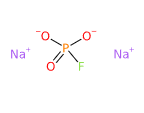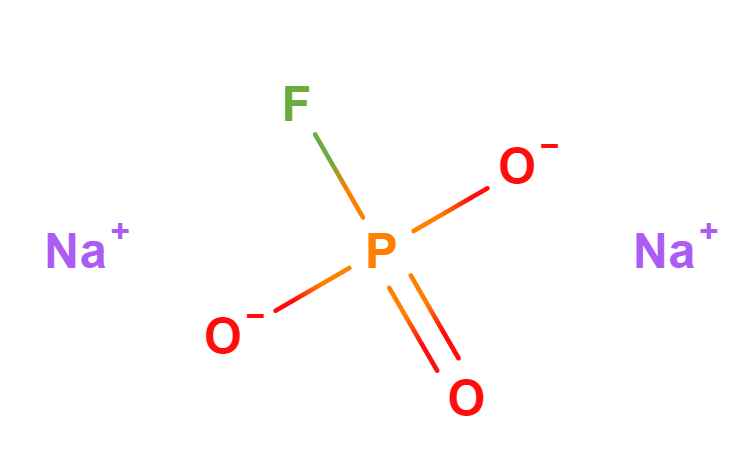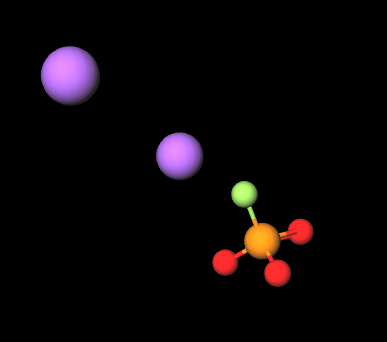App "Tiiips Ingredients Pro", Live Healthier!


App "Tiiips Ingredients Pro", Live Healthier!


| "Descrizione" by Ark90 (12431 pt) | 2023-Aug-19 16:03 |
| Evaluation | N. Experts | Evaluation | N. Experts |
|---|---|---|---|
| 1 | 6 | ||
| 2 | 7 | ||
| 3 | 8 | ||
| 4 | 9 | ||
| 5 | 10 |
Sodium monofluorophosphate is an inorganic chemical compound produced synthetically by the reaction of sodium fluoride with sodium metaphosphate or the reaction of disodium phosphate or tetrasodium pyrophosphate with hydrogen fluoride.
The name defines the structure of the molecule:
Description of the raw materials used in its production:
The synthesised extraction process takes place in four steps:
It appears in the form of a white powder, easily soluble in water at 42% at 25°C and strongly hygroscopic, Incompatible with phosphorus oxides, strong oxidising agents.

What it is used for and where
Dentistry
Used in toothpastes for enamel protection, anti-caries agent, dentine desensitisation. Sodium fluoride substitute. Sodium monofluorophosphate generally accounts for 0.7-0.76% in toothpaste ingredients and has virtually replaced sodium fluoride. Fungicide and preservative.
Safety
Maximum concentration in the ready-to-use preparation: 0.15% calculated as Fluorine. When mixed with other fluorine compounds permitted by this annex, the total concentration of F shall not exceed 0.15%.
Formulation of conditions of use and warnings: Contains sodium monofluorophosphate. For any toothpaste containing 0.1 to 0.15 percent fluoride, unless it is already labeled as contraindicated for children (e.g., "for adult use only"), the following labeling is mandatory: "Children 6 years of age or younger: Use a minimum amount for supervised brushing to minimize ingestion." In case of fluoride intake from other sources, consult a dentist or physician."
Cosmetics
It is a restricted ingredient III/27 as a Relevant Item in the Annexes of the European Cosmetics Regulation No. 1223/2009.
Anti-plaque agent. It is an ingredient that has the property of preventing the occurrence of caries by fighting the bacteria responsible for acid corrosion of teeth.
Oral hygiene agent. This ingredient can be inserted into the oral cavity of to improve and/or maintain its oral hygiene and health, to prevent or improve a disorder of the teeth, gums, mucosa.
Other uses
Metal surface cleaning, special glass production, drinking water fluorination, concrete corrosion inhibitor
Commercial applications
Fluoridating Agent in Toothpastes. Sodium Monofluorophosphate is used in toothpastes to help prevent tooth decay.
Component in Oral Care Products. Used in mouthwashes and other oral care products to promote tooth health.
Preservative Agent for Dental Materials. It can be used in dental materials as a preservative and stabilizing agent.
Ingredient in Pharmaceutical Preparations. Used in some pharmaceutical preparations for its antimicrobial properties.
For more information:
Sodium monofluorophosphate studies
Typical characteristics of the commercial product Sodium monofluorophosphate for use in toothpastes
| Appearance | White powder |
| pH | 6.5-8.0 |
| Melting Point | 625°C |
| Apparent Density | 1.5 g/cm3 |
| PSA | 73.00000 |
| LogP | 0.92500 |
| Na | ≥32.0% |
| Arsenic | ≤0.0003% |
| Lead | ≤0.0001% |
| Heavy metal | ≤0.005% |
| P (P2O5) | ≥49.0% |
| Combined fluorine | ≥12.49% |
| Free fluorine | ≤0.5% |
| Total F | ≥13.0% |
| F Combined in PO3F2- | ≥12.54% |
| Loss on dry (105℃/2H) | ≤0.2% |
| Whiteness (70-90umGranularity) | ≥94% |
| Transmission (15% Aq.solution) | ≥89% |
| Mesh granularity | 90% pass 100-200 mesh |
| Shelf life | 2 years |
| Chemical Safety |  |
 |  |
 |  |
Synonyms:
References____________________________________________________________________
Satyawan G. Damle, D Deoyani, Hiteshwar Bhattal, Renu Yadav, Ashish Lomba Comparative efficacy of dentifrice containing sodium monofluorophosphate + calcium glycerophosphate and non-fluoridated dentifrice: A randomized, double-blind, prospective study Dent Res J (Isfahan) 2012 Jan-Mar
Grewal N, Sharma N, Kaur N. Surface remineralization potential of nano-hydroxyapatite, sodium monofluorophosphate, and amine fluoride containing dentifrices on primary and permanent enamel surfaces: An in vitro study. J Indian Soc Pedod Prev Dent. 2018 Apr-Jun;36(2):158-166. doi: 10.4103/JISPPD.JISPPD_142_17
Gallob J, Sufi F, Amini P, Siddiqi M, Mason S. A randomised exploratory clinical evaluation of dentifrices used as controls in dentinal hypersensitivity studies. J Dent. 2017 Sep;64:80-87. doi: 10.1016/j.jdent.2017.06.009. Epub 2017 Jun 23.
Parkinson CR, Siddiqi M, Mason S, Lippert F, Hara AT, Zero DT. Anticaries Potential of a Sodium Monofluorophosphate Dentifrice Containing Calcium Sodium Phosphosilicate: Exploratory in situ Randomized Trial. Caries Res. 2017;51(2):170-178. doi: 10.1159/000453622. Epub 2017 Feb 21.
| Evaluate |